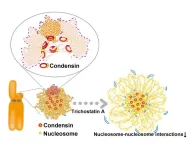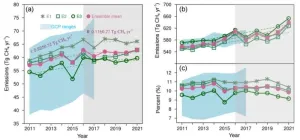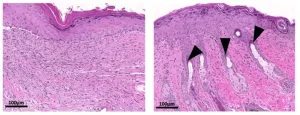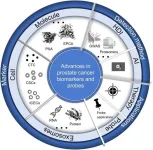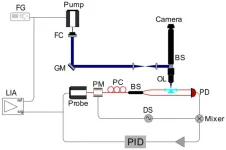Temperature regulates negative supercoils to modulate meiotic crossovers and chromosome organization
2024-08-23
(Press-News.org)
This study is led by Prof. Shunxin Wang (State Key Laboratory of Reproductive Medicine and Offspring Health, Center for Reproductive Medicine, Institute of Women, Children and Reproductive Health, Shandong University) and Prof. Liangran Zhang (Advanced Medical Research Institute, Shandong University). In their study of meiosis in budding yeast, the research team found that yeast senses temperature changes by increasing the level of DNA negative supercoils to increase crossovers and modulate chromosome organization during meiosis.
Meiosis is a specialized cell division producing gametes with the half chromosome complement of their progenitor cells. Meiotic crossovers between homologous (maternal and paternal) chromosomes, which result in the reciprocal exchange of chromosome fragments, play two important roles: physically holding the homologous chromosomes together to ensure their proper segregation, and promoting the genetic diversity of their progeny. The formation of crossovers is regulated by the architecture of meiotic chromosomes, each of which is organized as a linear array of loops anchored at their bases to a proteinaceous axis.
The researchers studied yeast meiosis, and found that changes in temperature (either decreased or increased) resulted in shorter meiotic chromosome axes and more crossovers. The research teams further found that temperature changes coordinately enhanced the hyperabundant distribution of axis proteins (such as Red1 and Hop1) on chromosomes and the number of putative crossover marker Zip3 foci. Importantly, temperature-induced changes in the distribution of axis proteins and Zip3 foci depend on changes in DNA negative supercoils, which have been shown to regulate the number of crossovers. In addition, temperature changes regulate the abundance of axis-associated proteins and thus axis length, independently of changes in DNA negative supercoils. These results suggest that yeast meiosis senses temperature changes by increasing the level of DNA negative supercoils to increase the number of crossovers and modulate chromosome organization.
These findings provide a new perspective on understanding the effect and mechanism of temperature on meiotic crossovers and chromosome organization, with important implications for evolution and breeding.
See the article:
Temperature regulates negative supercoils to modulate meiotic crossovers and chromosome organization.
https://doi.org/10.1007/s11427-024-2671-1
END
ELSE PRESS RELEASES FROM THIS DATE:
2024-08-23
Individual cells divide through a process called mitosis, during which the cell’s copied DNA is separated between two resulting daughter cells. Despite recent advances in cell biology, the mechanism by which DNA condenses during mitosis is still poorly understood. Researchers recently tracked small stretches of DNA wound around histone proteins, called nucleosomes, to better characterize nucleosome behavior during cell division.
DNA is organized as chromatin, which are dynamic structures comprised of DNA, RNA, and proteins that regulate the accessibility of genes for expression and the overall configuration of genetic material in the cell. Histone proteins, for example, are positively ...
2024-08-23
Methane is a potent greenhouse gas. Since the Industrial Revolution, atmospheric methane concentrations have nearly doubled, with its radiative forcing accounting for one-third of all greenhouse gases. As one of the world's largest methane emitters, China made a clear commitment as early as 2007 to "strive to control the growth rate of methane emissions." The country's 12th, 13th, and 14th Five-Year Plans all proposed measures to control methane emissions. In 2023, China released the "Methane Emission Control Action ...
2024-08-23
The income and education levels of a child’s environment determine their relationship to nature, not whether they live in a city or the countryside. This is the finding of a new study conducted by researchers at Lund University, Sweden. The results run counter to the assumption that growing up in the countryside automatically increases our connection to nature, and yet the study also shows that nature close to home increases children’s well-being.
There is a general concern that, with urbanisation, people have lost contact with nature. According to research, less contact ...
2024-08-23
An international study led by Institute of Natural Resources and Agrobiology of Seville (IRNAS-CSIC), of the Spanish National Research Council (CISC), has shown that as the number of global change factors increases, terrestrial ecosystems become more sensitive to the impacts of global change. The results, published in the prestigious journal Nature Geoscience, show that the resistance of our ecosystems to global change decreases significantly as the number of environmental stressors increases, especially when this stress is sustained over time.
This is the conclusion reached by the Biodiversity and Ecosystem Functioning ...
2024-08-23
Researchers at Rutgers University in New Jersey have discovered that a protein produced by parasitic worms in the gut enhances wound healing in mice. The study, to be published August 23 in the journal Life Science Alliance (LSA), reveals that applying the protein to skin wounds speeds up wound closure, improves skin regeneration, and inhibits the formation of scar tissue. Whether the protein can be harnessed to enhance wound healing in human patients remains to be seen.
Skin wounds must be rapidly closed in order to prevent infection, but rapid wound closure can favor the development of scar tissue instead of properly regenerated skin. The balance between scarring ...
2024-08-23
In a recent comprehensive review published in Cyborg Bionic Systems, researchers led by Keyi Li from the General Hospital of Northern Theater Command in Shenyang, along with international collaborators, detail significant advances in the identification and application of biomarkers for prostate cancer (PCa). This critical insight is pivotal as prostate cancer remains one of the most common malignancies among men globally, emphasizing the urgent need for effective diagnostic and therapeutic strategies.
Prostate cancer is characterized by a multitude of molecular aberrations that complicate its early ...
2024-08-23
A team of researchers led by Professor Sebastian Deindl at Uppsala University has developed a pioneering method that vastly improves the ability to observe and analyse complex biological processes at the single-molecule level. Their work is set to be published in the upcoming issue of the journal Science.
“With our new technique, we can now extend single-molecule biophysics to the genome scale. This advance is expected to significantly deepen our understanding of how nucleic-acid interacting proteins function in ...
2024-08-23
The detection of individual particles and molecules has opened new horizons in analytical chemistry, cellular imaging, nanomaterials, and biomedical diagnostics. Traditional single-molecule detection methods rely heavily on fluorescence techniques, which require labeling of the target molecules. In contrast, photothermal microscopy has emerged as a promising label-free, non-invasive imaging technique. This method measures localized variations in the refractive index of a sample's surroundings, resulting from light absorption by sample components, which induces temperature changes in the surrounding region. Whispering ...
2024-08-23
Dementia with Lewy bodies is a type of dementia that is similar to both Alzheimer’s disease and Parkinson’s disease but studies on long-term treatments are lacking. A new study from Karolinska Institutet in Sweden, published in Alzheimer’s & Dementia: The Journal of the Alzheimer's Association, highlights the potential cognitive benefits of cholinesterase inhibitor treatment.
Lewy body disease, which includes dementia with Lewy bodies (DLB) and Parkinson’s disease with and without dementia, is the second most common neurodegenerative disorder, following Alzheimer’s disease. DLB accounts for approximately ...
2024-08-23
NEW YORK, August 23, 2024 — In a groundbreaking advancement, researchers with the Advanced Science Research Center at the CUNY Graduate Center (CUNY ASRC) have experimentally demonstrated that metasurfaces (two-dimensional materials structured at the nanoscale) can precisely control the optical properties of thermal radiation generated within the metasurface itself. This pioneering work, published in Nature Nanotechnology, paves the way for creating custom light sources with unprecedented capabilities, ...
LAST 30 PRESS RELEASES:
[Press-News.org] Temperature regulates negative supercoils to modulate meiotic crossovers and chromosome organization
